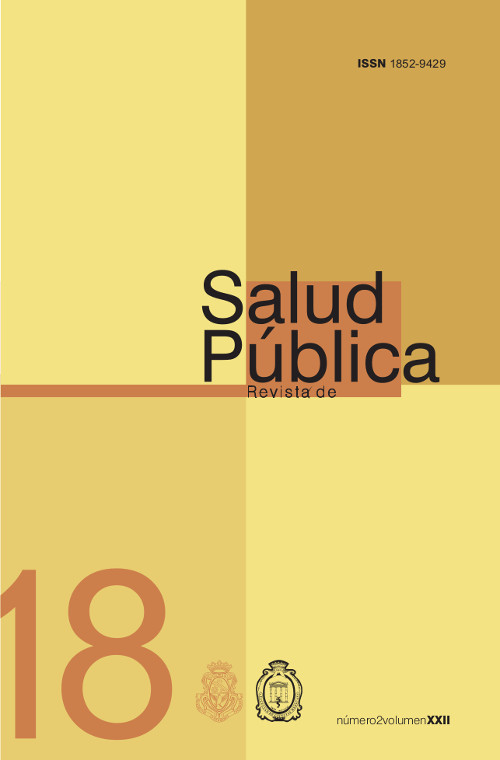SELF-EFFICACY AND TOBACCO CESSATION IN 100% TOBACCO SMOKE FREE AREAS
DOI:
https://doi.org/10.31052/1853.1180.v22.n2.19162Keywords:
Tobacco smoke free areas, self efficacy, cessation, tobacco, Mexico.Abstract
Abstract:
Objectives: To determine the level of self-efficacy in tobacco
cessation in university students were the strategy 100% tobacco smoke free areas has been implemented. Method: Transversal, descriptive and comparative study in three Academic Areas through stratified sampling by academic program with proportional distribution, multistage. The General Self-Efficacy Scale wasapplied (GSE). Results: Is was observed that in Health Sciences there is a smaller percentage of students with high self efficiency to quit smoking. Regarding the area of Humanities, the percentage was greater than 50%, that is to say, 66.8% of students are found with more frequency of exposition to tobacco smoke daily, due to the fact that the area has not taken the compromise of tobacco smoke free areas. Conclusions: Self efficacy has been relevant to approach topics related to health behaviors such as smoking.
Downloads
References
(1) Organización Mundial de la Salud (2008). MPOWER Un plan de medidas para hacer retroceder la epidemia de tabaquismo. Recuperado de http://www.who.int/tobacco/mpower/mpower_spanish.pdf
(2) U.S. Department of Health and Human Services, National Institutes of Health, National Institute of Environmental Health Sciences, National Toxicology Program. Report on Carcinogens, Eleventh Edition. Washington DC: Department of Health and Human Services; 2005. Disponible en: http://ntp.niehs.nih.gov/ntp/roc/eleventh/profiles/s176toba.pdf
(3) World Health Organization (2011). WHO report on the global tobacco epidemic, 2011: warning about the dangers of tobacco. Recuperado de http://www.who.int/tobacco/global_report/2011/en/index.html
(4) Organización Mundial de la Salud (2003). Convenio Marco para el Control del Tabaco. Recuperado de http://www.who.int/tobacco/framework/WHO_fctc_spanish.pdf
(5) Secretaría de Salud (2009). Ley General de Control del Tabaco y su Reglamento. Recuperado de http://www.cusxxi.edu.mx/pdfs/LEY_GENERAL_PARA_EL_CONTROL_DEL_TABACO_Y_SU_REGLAMENTO.pdf
(6) Gaceta Oficial del Estado de Veracruz (2012). Ley Número 327 para la Protección de los No Fumadores. Recuperado: https://cutt.ly/ke8cPYU
(7) Universidad Veracruzana (2011). Consejo Universitario. Declaratoria de los Espacios Universitarios 100% Libres de Humo de Tabaco 12 de diciembre de 2011. Recuperado: https://colaboracion.uv.mx/rept/files/marco-juridico/3-Reglamentos/Reglamento-de-Espacios-Universitarios-Cien-por-Ciento-Libres-de-Humo-de-Tabaco.pdf
(8) Bandura A. (1977) Self-efficacy: Toward a unifying theory of behavioral change. Psychological Review, 84, 191- 215.
(9) Bandura A. (1987) Pensamiento y acción: fundamentos sociales. Barcelona: Martínez Roca.
(10) Bandura A. 1997 Self-efficacy: the exercise of control. New York: W.H. Freeman.
(11) Bandura A. (8) (2001). Guía para la construcción de escalas de autoeficacia. Evaluar.
http://www.revistaevaluar.com.ar/effguideSpanish.htm
(12) Schwarzer y Jerusalem, 1995 en Luszczynska, Gibbons, Piko&Tekosel, 2004, Choi 2004; Self-regulatory cognitions, social comparison, perceived peers’ behaviors as predictors of nutrition and physical activity: A comparison among adolescents in Hungary, Poland, Turkey, and USA. Psychology and Health, 19, 577-593
(13) Luszczynska, A.; Scholz, U. & Schwarzer, R. (2005). The general self-efficacy scale: Multicultural validation studies. The Journal of Psychology, 139 (5), 439-457
(14) Palacios J. Autoeficacia e intención conductual del consumo de tabaco en adolescentes: validez factorial y relación estructural. Revista Adicciones, vol. 22, núm. 4, 2010. Disponible en: http://www.redalyc.org/articulo.oa?id=289122896006
(15) Villamarín Francisco. Autoeficacia: investigaciones en Psicología de la Salud [Internet] (1994) Universitat Autonoma de Barcelona. Anuario de Psicología no. 61, 9-18
(16) Universidad Veracruzana (2016). Anuario de Información Est adística Institucional. Recuperado: https://www.uv.mx/informacion-estadistica/anuario/
(17) Pérez, Bermúdez y Sanjuán, 2000. Escala de autoeficacia general: datos psicométricos de la adaptación para población española Psicothema, 12(Supl. 2), 509-513.
(18) Encuesta Nacional de Adicciones 2011. Reporte de Tabaco Primera edición 2012. Instituto Nacional de Psiquiatría Ramón de la Fuente Muñiz (INPRFM)
(19) Forsyth y Carey, 1998. Measuring Self –Efficacy in the context of HIV risk reduction: Research challenges and recommendations. Health Psychology, 17 (6) 559-568.
(20) Olivari Medina Cecilia, Urra Medina Eugenia. Autoeficacia Y Conductas De Salud. Cienc. enferm. [Internet]. 2007 Jun [citado 2018 Ene 09] ; 13( 1 ): 9-15. Disponible en: http://www.scielo.cl/scielo.php?script=sci_arttext&pid=S0717-95532007000100002&lng=es. http://dx.doi.org/10.4067/S0717-95532007000100002.
(21) Grembowski, D., Patrick, D., Diehr, P., Durham, M., Beresford, S., Kay, E. & Hecht, J. (1993). Self-efficacy and behavior among older adults. Journal of Health and Social Behavior, 34, 89-104.
(22) Bandura, A. (2005). Guide for constructing self-efficacy scales. En F. Pajares y T. Urdan (Eds.), Self-efficacy beliefs of adolescents (vol. 5, pp. 307-337). Greenwich, CT: Information Age Publishing.
(23) Martínez Maldonado Raúl, Pedrão Luiz Jorge, Alonso Castillo María Magdalena, López García Karla Selene, Oliva Rodríguez Nora Nely. Autoestima, autoeficacia percibida, consumo de tabaco y alcohol en estudiantes de educación secundaria de área urbana y rural de Monterrey, Nuevo León, México. Rev. Latino-Am. Enfermagem [Internet]. 2008 Aug [cited 2018 Jan 09] ; 16( spe ): 614-620. Available from: http://www.scielo.br/scielo.php?script=sci_arttext&pid=S0104-11692008000700018&lng=en. http://dx.doi.org/10.1590/S0104-11692008000700018.
(24) Villa Rivas Fani, Autoeficacia percibida y consumo de tabaco y alcohol en estudiantes de secundaria. (2005) Tesis. Universidad Autónoma de Nuevo León. Disponible en: http://eprints.uanl.mx/6823/1/1080128589.pdf
Downloads
Published
Issue
Section
License
Copyright (c) 2018 Escuela de Salud Pública y Ambiente. Facultad de Ciencias Médicas. Universidad Nacional de Córdoba

This work is licensed under a Creative Commons Attribution-NonCommercial 4.0 International License.
Authors who publish with this journal agree to the following terms:
- Authors retain copyright and grant the journal right of first publication with the work simultaneously licensed under a Creative Commons Attribution License which allows the work to be copied, distributed, exhibited and interpreted as long as it is not done for commercial purposes.
- Authors are able to enter into separate, additional contractual arrangements for the non-exclusive distribution of the journal's published version of the work (e.g., post it to an institutional repository or publish it in a book), with an acknowledgement of its initial publication in this journal.
- Authors are permitted and encouraged to post their work online (e.g., in institutional repositories or on their website) after the publication process. (See The Effect of Open Access). (See The Effect of Open Access).







